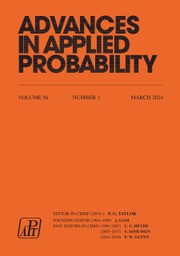Crossref Citations
This article has been cited by the following publications. This list is generated based on data provided by
Crossref.
Tweedie, R.L.
1977.
Hitting times of Markov chains, with application to state-dependent queues.
Bulletin of the Australian Mathematical Society,
Vol. 17,
Issue. 1,
p.
97.
Tweedie, R. L.
1977.
Criteria for classifying general Markov chains.
Advances in Applied Probability,
Vol. 9,
Issue. 2,
p.
208.
Tweedie, R. L.
1977.
Criteria for classifying general Markov chains.
Advances in Applied Probability,
Vol. 9,
Issue. 02,
p.
208.
Isaacson, Dean
and
Tweedie, Richard L.
1978.
Criteria for strong ergodicity of Markov chains.
Journal of Applied Probability,
Vol. 15,
Issue. 01,
p.
87.
Tweedie, R.L.
and
Westcott, M.
1978.
First-passage times in skip-free processes.
Stochastic Processes and their Applications,
Vol. 7,
Issue. 2,
p.
191.
Arjas, Elja
Nummelin, Esa
and
Tweedie, Richard L.
1978.
Uniform limit theorems for non-singular renewal and Markov renewal processes.
Journal of Applied Probability,
Vol. 15,
Issue. 01,
p.
112.
Laslett, G. M.
Pollard, D. B.
and
Tweedie, R. L.
1978.
Techniques for establishing ergodic and recurrence properties of continuous‐valued markov chains.
Naval Research Logistics Quarterly,
Vol. 25,
Issue. 3,
p.
455.
Tuominen, Pekka
and
Tweedie, Richard L.
1979.
Exponential ergodicity in Markovian queueing and dam models.
Journal of Applied Probability,
Vol. 16,
Issue. 04,
p.
867.
Arjas, E.
Nummelin, E.
and
Tweedie, R. L.
1980.
Semi-Markov processes on a general state space: α-theory and quasi-stationarity.
Journal of the Australian Mathematical Society. Series A. Pure Mathematics and Statistics,
Vol. 30,
Issue. 2,
p.
187.
Athreya, K. B.
Tweedie, R. L.
and
Vere-Jones, D.
1980.
Asymptotic behaviour of point processes with Markov-dependent intervals.
Mathematische Nachrichten,
Vol. 99,
Issue. 1,
p.
301.
Tweedie, R. L.
1980.
Perturbations of countable Markov chains and processes.
Annals of the Institute of Statistical Mathematics,
Vol. 32,
Issue. 2,
p.
283.
Wolf, D.
1980.
Approximation of the invariant probability measure of an infinite stochastic matrix.
Advances in Applied Probability,
Vol. 12,
Issue. 3,
p.
710.
Wolf, D.
1980.
Approximation of the invariant probability measure of an infinite stochastic matrix.
Advances in Applied Probability,
Vol. 12,
Issue. 3,
p.
710.
Hajek, Bruce
1982.
Hitting-time and occupation-time bounds implied by drift analysis with applications.
Advances in Applied Probability,
Vol. 14,
Issue. 3,
p.
502.
Tweedie, R. L.
1982.
Operator-geometric stationary distributions for markov chains, with application to queueing models.
Advances in Applied Probability,
Vol. 14,
Issue. 2,
p.
368.
Nummelin, Esa
and
Tuominen, Pekka
1982.
Geometric ergodicity of Harris recurrent Marcov chains with applications to renewal theory.
Stochastic Processes and their Applications,
Vol. 12,
Issue. 2,
p.
187.
Tweedie, R. L.
1982.
Operator-geometric stationary distributions for markov chains, with application to queueing models.
Advances in Applied Probability,
Vol. 14,
Issue. 2,
p.
368.
Daley, D. J.
and
Haslett, J.
1982.
A thermal energy storage process with controlled input.
Advances in Applied Probability,
Vol. 14,
Issue. 2,
p.
257.
Tweedie, R. L.
1983.
The existence of moments for stationary Markov chains.
Journal of Applied Probability,
Vol. 20,
Issue. 01,
p.
191.
1984.
Markov Chains.
Vol. 11,
Issue. ,
p.
356.

